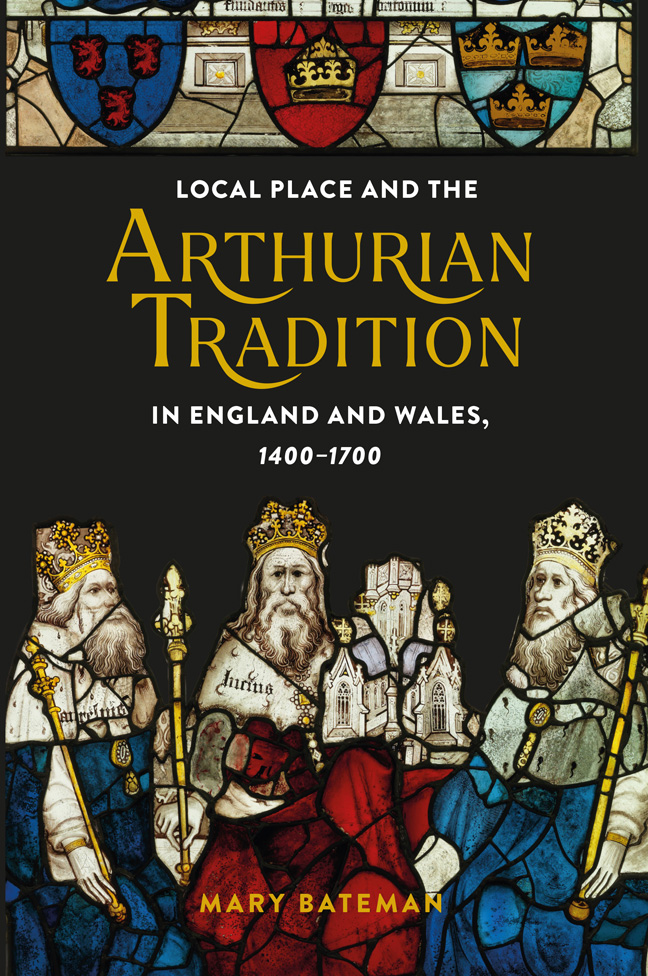Book contents
- Frontmatter
- Contents
- List of Illustrations
- Acknowledgements
- Introduction: Place and the defence of Arthur
- 1 ‘Thise were his places and his habitacions’: Arthur in situ in the fifteenth century
- 2 Contentious places: Reconciling Arthurian places in the fifteenth century
- 3 The best of the west: John Leland's West Country Arthur
- 4 Locating Arthur in England and Wales: John Leland, John Prise, and Elis Gruffydd
- 5 Placing Arthur in William Camden's Britannia
- Coda: Arthur's local renaissance?
- Bibliography
- Index
- Miscellaneous Endmatter
Introduction: Place and the defence of Arthur
Published online by Cambridge University Press: 21 February 2024
- Frontmatter
- Contents
- List of Illustrations
- Acknowledgements
- Introduction: Place and the defence of Arthur
- 1 ‘Thise were his places and his habitacions’: Arthur in situ in the fifteenth century
- 2 Contentious places: Reconciling Arthurian places in the fifteenth century
- 3 The best of the west: John Leland's West Country Arthur
- 4 Locating Arthur in England and Wales: John Leland, John Prise, and Elis Gruffydd
- 5 Placing Arthur in William Camden's Britannia
- Coda: Arthur's local renaissance?
- Bibliography
- Index
- Miscellaneous Endmatter
Summary
Places are powerful. Even when we visit the settings for works of fiction, we find ourselves suspending our disbelief. Several literary geographies have sparked successful tourism industries: Thomas Hardy's Wessex, for example, or the Brontës’ home in Haworth. Literary tourism has a surprisingly long history: a fifteenth-century continuation of The Canterbury Tales which describes the pilgrims’ experience after arriving at Canterbury Cathedral appears to have been composed by a monk at the cathedral responsible for administering St Thomas Becket's shrine (and perhaps guiding visiting pilgrims). Of course, Chaucer's Tales were not the key motivation for pilgrims travelling to Canterbury, but the existence of this text suggests that on-site interpreters responsible for choreographing pilgrims’ experiences were engaging with the Cathedral's literary connotations. Recognisable stories can illuminate our experiences of particular places.
In the same vein, sites associated with King Arthur continue to attract visitors. Across the English and Welsh landscape, Arthur's name keeps appearing: as W. H. Dickinson observes, ‘only the Devil is more often mentioned in local association than Arthur’. At Glastonbury, Arthur has been swept up into the town's thriving New Age tourist economy, and his purported grave site at Glastonbury Abbey, discovered in 1191, is no longer the only site of Arthurian interest in the town. Visitors climb Glastonbury Tor, now associated widely with the Avalon of Arthurian tradition, and drink from the waters of the Chalice Well said to have sprung from the Holy Grail buried somewhere nearby. Likewise, Tintagel, associated with King Arthur since at least the twelfth century, remains one of English Heritage's most visited sites. Arthur is unquestionably the key draw: in 2010, interviews conducted with visitors to Tintagel Castle demonstrated that visitors reacted with discomfort to attempts to disrupt their suspended disbelief in Arthur. Today, Tintagel is more than just the castle; James Noble memorably described the integrated Arthurian tourism experience at Tintagel in the 1990s as ‘the best of English Twinkie’, enumerating the various Arthur-themed museums, hotels, restaurants, and souvenir shops lining the streets of the town.
While Arthur's tourist appeal today is obvious, the long history of Arthurian tourism is less well-recognised. From at least the fourteenth century, and perhaps even earlier, custodians of religious and secular sites with Arthurian connections carefully curated their sites’ histories for the benefit of their visitors.
- Type
- Chapter
- Information
- Publisher: Boydell & BrewerPrint publication year: 2023



